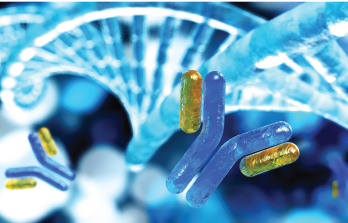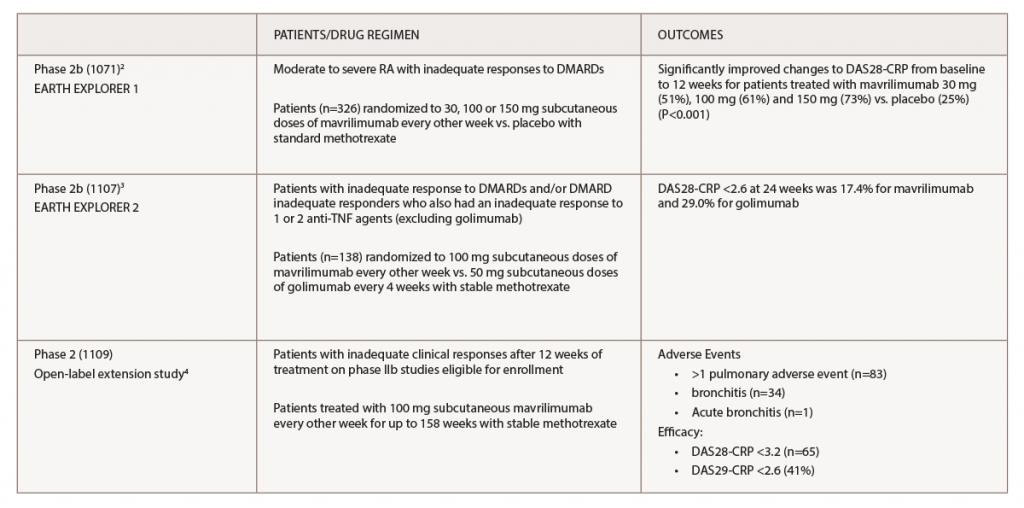
ustas7777777 / shutterstock.com
Recent data showing sustained, long-term safety and efficacy of mavrilimumab for the treatment of rheumatoid arthritis (RA) confirm and build on prior evidence from phase 2 studies of the potential for this new agent for the treatment of RA.
Mavrilimumab is a human monoclonal antibody that blocks a proinflammatory cytokine involved in RA pathogenesis—granulocyte-macrophage colony-stimulating factor (GM-CSF)—and is the first agent targeting the receptor of this cytokine.
The study found mavrilimumab remained well tolerated with only mild or moderate adverse events and no signs of pulmonary deterioration. In addition, long-term efficacy was maintained.1
“These results support data from previous studies,” says lead author of the study, Gerd R. Burmester, MD, professor of medicine and director of the Department of Rheumatology and Clinical Immunology, Charité-University Medicine Berlin, Germany.
Unique to this study was the use of multiple pulmonary function tests to provide a longitudinal, long-term assessment of pulmonary function. A particularly important finding was that no pulmonary deterioration occurred with long-term use of mavrilimumab. Identifying long-term effects of mavrilimumab on pulmonary function is particularly important given the potential harmful effects of blocking GM-CSF, which plays a critical role in lung homeostasis and promoting alveolar macrophage development.
A particularly important finding was that no pulmonary deterioration occurred with long-term use of mavrilimumab.
A Closer Look

Dr. Burmester
In the study, Dr. Burmester and his colleagues pulled together data from three prior studies of mavrilimumab to assess sustained safety and efficacy for up to three years.2-4 Table 1 lists the studies.
When combining the safety data from these studies, Burmester and colleagues found that 442 patients from these three studies received 100 mg mavrilimumab every other week with a cumulative mavrilimumab safety exposure of 899 patient-years. Of the treatment-emergent adverse events reported, most were mild to moderate, with nasopharyngitis as the most common (n=69; 7.68 per 100 patient-years) followed by bronchitis (n=51; 5.68 per 100 patient-years). The study also found low incidences of neutropenia (0.90%; 0.54 per 100 patient-years) and serious infections (3.17%; 1.56 per 100 patient-years). There were no reports of monocytopenia.

(click for larger image) Table 1. Key: DAS28-CRP, Disease Activity Score in 28 Joints; DMARDs, disease-modifying anti-rheumatic drugs; TNF, tumor necrosis factor
“Importantly,” says Dr. Burmester, “pulmonary deterioration was not evident with long-term mavrilimumab treatment in addition to standard care.”
Pulmonary function and long-term pulmonary safety are listed in Table 2. The multiple pulmonary tests used to test lung function and long-term safety included serial standardized lung function testing (FEV1/FVC), assessments of dyspnea using the Borg Dyspnea Index and chest radiographs.

(click for larger image) Table 2. Pulmonary Function*
*Most pulmonary changes were transient and infrequently associated with adverse events.
Dr. Burmester also highlights the sustained efficacy found when combining the trial data. “We observed clinically meaningful, long-term efficacy in patients receiving mavrilimumab for up to more than three years across many disease activity parameters.”
The study found that efficacy was sustained, with 65% of patients achieving a DAS28-CRP of <3.2 and 40.6% of patients achieving DAS28-CRP of <2.6.

Prof. Hamilton
Commenting on the study, Professor John Hamilton, PhD, DSc, Department of Medicine, University of Melbourne, The Royal Melbourne Hospital, Parkville, Victoria, Australia, underscores the safety results and sustained benefits found in the study. “There were no serious adverse events following a unique and detailed analysis, particularly of pulmonary function,” he says. “Long-term treatment was associated with clear and sustained benefits in measures of RA disease which were similar to those reported in early phase 2 studies.”
An important finding verified in the study was that a higher dose of mavrilimumab is needed given the findings of the phase 2 1071 study, in which 150 mg conferred the greatest benefit.2 “It is recommended that phase 3 studies be undertaken using a higher dose,” says Professor Hamilton.
Biomarkers
Along with assessing safety and long-term efficacy outcomes of these three trials, Dr. Burmester and colleagues analyzed biomarkers related to the GM-CSF pathway to better understand the mechanisms of action of mavrilimumab. As in previous studies, this study found and confirmed two biomarkers specifically related to the GM-CSF pathway: CCL17/TARC and CCL22/MDC.1-3
“These biomarkers indicate a potential benefit of inhibiting this pathway in RA treatment,” says Dr. Burmester.
Professor Hamilton agrees. He says the identified biomarkers “may be useful” when designing and implementing future phase 3 trials of mavrilimumab.
Mary Beth Nierengarten is a freelance medical journalist based in Minneapolis.
References
- Burmester GR, McInnes IB, Kremer JM, et al. Mavrilimumab, a fully human granulocyte-macrophage colony-stimulating factor receptor α monoclonal antibody: Long-term safety and efficacy in patients with rheumatoid arthritis. Arthritis Rheumatol. 2018 May;70(5):679–689.
- Burmester GR, McInnes IB, Kremer J, et al. A randomised phase IIb study of mavrilimumab, a novel GM-CSF receptor a monoclonal antibody, in the treatment of rheumatoid arthritis. Ann Rheum Dis. 2017 Jun;76(6):1020–1030.
- Weinblatt M, McInnes I, Kremer J, et al. EARTHEXPLORER 2, a phase IIb exploratory study evaluating efficacy and safety of mavrilimumab, a fully human granulocyte-macrophage colony-stimulating factor receptor-α monoclonal antibody, and the tumor necrosis factor antagonist golimumab in rheumatoid arthritis [abstract 1619]. Arthritis Rheumatol. 2016;68(suppl 10).
- Burmester GR, McInnes IB, Kremer JM, et al. Mavrilimumab, a fully human granulocyte-macrophage colony-stimulating factor receptor-α monoclonal antibody: Long-term safety and efficacy for up to 158 weeks of treatment in patients with rheumatoid arthritis [abstract 1616]. Arthritis Rheumatol. 2016;68(suppl 10).

